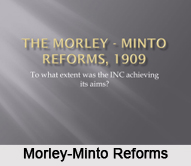 The Indian Council Acts were the Acts of Parliament of the United Kingdom. They were the Indian Councils Act of1861, Indian Councils Act of1892 and Indian Councils Act of 1909. These acts are described below.
The Indian Council Acts were the Acts of Parliament of the United Kingdom. They were the Indian Councils Act of1861, Indian Councils Act of1892 and Indian Councils Act of 1909. These acts are described below.
Indian Councils Act 1861
Indian Councils Act-1861 would link the Indians with the legislative activities. According to this act, the Viceroy of India`s executive council would be converted into a cabinet, run on the portfolio system. 6 "ordinary members" of the cabinet would handle 6 different departments of Calcutta`s government. They were home, revenue, military, law, finance and public works. Apart from the ordinary members, there was as an extraordinary member, that is, the military Commander-in-Chief. The Executive Council was expanded by the addition of a 5th member called the Jurist. The act resulted in the restoration of the legislative power of the Presidency Government (The Governments of Bombay and Madras were empowered to nominate the Advocate-General). The act led to the introduction of the Portfolio or Cabinet system in the Government of India. Civil Services became Indian Civil Services. The act vested the viceroy with the power to reject the council, if he considered it necessary.
Indian Councils Act 1892
Indian Councils Act-1892 was enacted on the demand of the Indian National Congress. This act permitted an increase in the size of the various legislative councils in British India. The number of non-official members was increased both in central and provincial legislative councils. The council would be empowered to discuss the budget and address questions to the executive.
Indian Councils Act 1909 (Morley-Minto Reforms)
Indian Councils Act-1909 or the Morley-Minto Reforms resulted in a limited increase in the involvement of Indians in the governance of British India. Due to the act, the election of Indians to the various legislative councils in India was effectively legitimized for the first time. The introduction of the electoral principle established the base for a parliamentary system. The act was significant in order to bring about Hindu-Muslim disunity. The Indian Councils Act, 1861 and the Indian Councils Act, 1892 were amended by the Indian Councils Act of 1909. Some of the provisions of the act are the increase in the maximum number of nominated and elected members of the Legislative Council at the center from 16 to 69 (excluding ex officio members), nomination of one Indian member to the Executive Council made by the Governor-General, nomination of two Indians to the Council of the Secretary of State for Indian Affairs and the right to separate electorate given bestowed upon the Muslims.



















